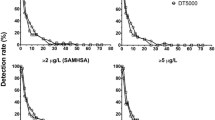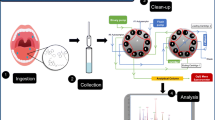Abstract
Oral fluid (OF) is an increasingly accepted matrix for drug testing programs, but questions remain about its usefulness for monitoring cannabinoids. Expectorated OF specimens (n = 360) were obtained from 10 adult daily cannabis smokers before, during, and after 37 20-mg oral Δ9-tetrahydrocannabinol (THC) doses over 9 days to characterize cannabinoid disposition in this matrix. Specimens were extracted and analyzed by gas chromatography–mass spectrometry with electron-impact ionization for THC, 11-hydroxy-THC, cannabidiol, and cannabinol, and negative chemical ionization for 11-nor-9-carboxy-THC (THCCOOH). Linear ranges for THC, 11-hydroxy-THC, and cannabidiol were 0.25–50 ng/mL; cannabinol 1–50 ng/mL; and THCCOOH 5–500 pg/mL. THCCOOH was the most prevalent analyte in 344 specimens (96.9%), with concentrations up to 1,390.3 pg/mL. 11-hydroxy-THC, cannabidiol, and cannabinol were detected in 1, 1, and 3 specimens, respectively. THC was detected in only 13.8% of specimens. The highest THC concentrations were obtained at admission (median 1.4 ng/mL, range 0.3–113.6) from previously self-administered smoked cannabis. A total of 2.5 and 3.7% of specimens were THC-positive at the recommended Substance Abuse and Mental Health Services Administration (2 ng/mL) and Driving Under the Influence of Drugs, Alcohol and Medicines (DRUID) (1 ng/mL) confirmation cutoffs, respectively. THC is currently the only analyte for monitoring cannabis exposure in OF; however, these data indicate chronic therapeutic oral THC administration and illicit oral THC use are unlikely to be identified with current guidelines. Measurement of THCCOOH may improve the detection and interpretation of OF cannabinoid tests and minimize the possibility of OF contamination from passive inhalation of cannabis smoke.

Median Δ9-tetrahydrocannabinol (THC) and 11-nor-9-carboxy-THC (THCCOOH) concentrations in expectorated oral fluid collected from 10 daily cannabis smokers over 9 days before, during, and after 37 20-mg oral THC doses. Arrows indicate the number of 20-mg THC doses ingested between collections



Similar content being viewed by others
References
Ledgerwood DM, Goldberger BA, Risk NK, Lewis CE, Price RK (2008) Comparison between self-report and hair analysis of illicit drug use in a community sample of middle-aged men. Addict Behav 33(9):1131–1139
Musshoff F, Driever F, Lachenmeier K, Lachenmeier DW, Banger M, Madea B (2006) Results of hair analyses for drugs of abuse and comparison with self-reports and urine tests. Forensic Sci Int 156(2–3):118–123
Kim I, Barnes AJ, Oyler JM, Schepers R, Joseph RE Jr, Cone EJ, Lafko D, Moolchan ET, Huestis MA (2002) Plasma and oral fluid pharmacokinetics and pharmacodynamics after oral codeine administration. Clin Chem 48:1486–1496
Crouch DJ (2005) Oral fluid collection: the neglected variable in oral fluid testing. Forensic Sci Int 150(2–3):165–173
Samyn N, van Haeren C (2000) On-site testing of saliva and sweat with Drugwipe and determination of concentrations of drugs of abuse in saliva, plasma and urine of suspected users. Int J Leg Med 113:150–154
Kaufman E, Lamster IB (2002) The diagnostic applications of saliva—a review. Crit Rev Oral Biol Med 13(2):197–212
Bosker WM, Huestis MA (2009) Oral fluid testing for drugs of abuse. Clin Chem 55(11):1910–1931
Moore C, Ross W, Coulter C, Adams L, Rana S, Vincent M, Soares J (2006) Detection of the marijuana metabolite 11-nor-delta9-tetrahydrocannabinol-9-carboxylic acid in oral fluid specimens and its contribution to positive results in screening assays. J Anal Toxicol 30(7):413–418
Kauert GF, Iwersen-Bergmann S, Toennes SW (2006) Assay of delta9-tetrahydrocannabinol (THC) in oral fluid-evaluation of the OraSure oral specimen collection device. J Anal Toxicol 30(4):274–277
Haney M, Ward AS, Comer SD, Foltin RW, Fischman MW (1999) Abstinence symptoms following oral THC administration to humans. Psychopharmacol 141:385–394
Food and Drug Administration (2004) MARINOL® (Dronabinol) Capsules. 500012 Rev Sep 2004 ed
Milman G, Barnes AJ, Lowe RH, Huestis MA (2010) Simultaneous quantification of cannabinoids and metabolites in oral fluid by two-dimensional gas chromatography mass spectrometry. J Chromatogr A 1217:1513–1521
Enberg N, Alho H, Loimaranta V, Lenander-Lumikari M (2001) Saliva flow rate, amylase activity, and protein and electrolyte concentrations in saliva after acute alcohol consumption. Oral Surg Oral Med Oral Pathol Oral Radiol Endod 92(3):292–298
de Almeida PDV, Grégio AMT, Machado MÂN, de Lima AAS, Azevedo LR (2008) Saliva composition and functions: a comprehensive review. J Contemp Dent Pract 9(3):72–80
Kintz P, Samyn N (2002) Use of alternative specimens: drugs of abuse in saliva and doping agents in hair. Ther Drug Monit 24:239–246
Hold KM, De Boer D, Zuidema J, Maes RAA (1996) Saliva as an analytical tool in toxicology. Int J Drug Test 1:1–31
Lillsunde P (2008) Analytical techniques for drug detection in oral fluid. Ther Drug Monit 30(2):181–187
Teixeira H, Proenca P, Verstraete A, Corte-Real F, Vieira DN (2005) Analysis of delta-9-tetrahydrocannabinol in oral fluid samples using solid-phase extraction and high-performance liquid chromatography-electrospray ionization mass spectrometry. Forensic Sci Int 150(2–3):205–211
Milman G, Barnes AJ, Schwope DM, Schwilke EW, Darwin WD, Goodwin RS, Kelly DL, Gorelick DA, Huestis MA (2010) Disposition of cannabinoids in oral fluid after controlled around-the-clock oral THC administration. Clin Chem 56(8):1261–1269
Kauert GF, Ramaekers JG, Schneider E, Moeller MR, Toennes SW (2007) Pharmacokinetic properties of delta9-tetrahydrocannabinol in serum and oral fluid. J Anal Toxicol 31(5):288–293
Niedbala RS, Kardos KW, Fritch DF, Kardos S, Fries T, Waga J, Robb J, Cone EJ (2001) Detection of marijuana use by oral fluid and urine analysis following single-dose administration of smoked and oral marijuana. J Anal Toxicol 25(5):289–303
DHHS (2004) Proposed revisions to mandatory guidelines for federal workplace drug testing programs. Fed Regist 69(71):19673–19732
Pil K, Raes E, Verstraete AG (2009) The toxicological challenges in the European research project DRUID. Forensic Sci Int Suppl Ser 1(1):29–32
Karschner E, Schwilke E, Lowe R, Darwin W, Pope H Jr, Herning R, Cadet J, Huestis M (2009) Do delta 9-tetrahydrocannabinol concentrations indicate recent use in chronic cannabis users? Addiction 104:2041–2048
Karschner E, Schwilke E, Lowe R, Darwin WD, Herning R, Cadet J, Huestis M (2009) Implications of plasma delta9-tetrahydrocannabinol, 11-hydroxy-THC, and 11-nor-9-carboxy-THC concentrations in chronic cannabis smokers. J Anal Toxicol 33(8):469–477
Wall ME, Sadler BM, Brine D, Taylor H, Perez-Reyes M (1983) Metabolism, disposition, and kinetics of delta-9-tetrahydrocannabinol in men and women. Clin Pharmacol Ther 34:352–363
Moore C, Rana S, Coulter C (2007) Simultaneous identification of 2-carboxy-tetrahydrocannabinol, tetrahydrocannabinol, cannabinol and cannabidiol in oral fluid. J Chromatogr B Anal Technol Biomed Life Sci 852(1–2):459–464
Acknowledgements
Supported by the Intramural Research Program, NIH, National Institute on Drug and NIDA Residential Research Support Services Contract HHSN271200599091 CADB Contract No N01Da-5-9909. We thank clinical research teams from the NIDA clinical program, the Johns Hopkins Behavioral Pharmacology Research Unit, and the Maryland Psychiatric Research Center Treatment Research Program.
Author information
Authors and Affiliations
Corresponding author
Electronic supplementary material
Below is the link to the electronic supplementary material.
ESM 1
(PDF 181 kb)
Rights and permissions
About this article
Cite this article
Milman, G., Barnes, A.J., Schwope, D.M. et al. Cannabinoids and metabolites in expectorated oral fluid after 8 days of controlled around-the-clock oral THC administration. Anal Bioanal Chem 401, 599–607 (2011). https://doi.org/10.1007/s00216-011-5066-4
Received:
Revised:
Accepted:
Published:
Issue Date:
DOI: https://doi.org/10.1007/s00216-011-5066-4




